 |






|
 |
 |
I. Globalisation, Technological Innovation, and Social Change: Molding
the 21st Century
The twentieth century bids farewell with the ambivalence of fundamental
shifts in the co-ordinate system of the industrial society and nation-state.
In this system, the general conditions of society were defined by two
conceptions: national state and national economy. The correlation of these
two ensured income growth in many countries as a result of efficient value
creation in market economies. Nation and society formed reference points
of collective identity and the framework for mediation of social and political
conflicts. The economic model was based on a market structure that rewarded
efficient efforts, favoured competition, and secured rights of ownership.
This was the basis of economic growth and of the ability to change structurally.
Within the framework of the nation-states' political constitution, political
civil liberties were clearly defined. Division of powers, along with parliamentary
government, guaranteed maximum supervision of those in power. Supported
by a broad political consensus of parties and interest groups, pluralistic
societies produced a settlement mechanism through which the denominational
and social conflicts of this stage of modern society could be moderated.
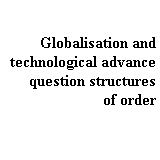 In
the age of globalisation, the ordering power of this conception is weakening.
The range and speed of this shift demand transformation of the organisational
structure of industrialized nations. On the threshold of the 21st century,
we are faced with a blueprint of the future depicting a transnationally
connected society, whose central economic resources consist neither of
iron and steel nor electricity and chemistry, nor of large industrial
organisations. Rather, these economies are based on knowledge, communication,
transnational networks and decentralised production. At the same time
the gap is widening between global reality and the out-dated leadership
experience of existing institutions. In
the age of globalisation, the ordering power of this conception is weakening.
The range and speed of this shift demand transformation of the organisational
structure of industrialized nations. On the threshold of the 21st century,
we are faced with a blueprint of the future depicting a transnationally
connected society, whose central economic resources consist neither of
iron and steel nor electricity and chemistry, nor of large industrial
organisations. Rather, these economies are based on knowledge, communication,
transnational networks and decentralised production. At the same time
the gap is widening between global reality and the out-dated leadership
experience of existing institutions.
In close connection with this transformation are the developments in biotechnology
and genetic engineering, which are paving the way to revolutionary innovations
in biomedicine, pharmacy and agriculture. Technological advance promises
a new dimension of shaping living conditions around the globe.
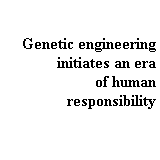 At
the same time, genetic engineering allows access to the biological architecture
of humankind and its potential is comparable to the Hippocratic revolution
2,500 years ago. The possibilities of genetic engineering allow the natural
history of the organism to pass into a new age, wherein the shaping of
life lies in human hands. The connection between information technology
and the advances in biological sciences changes the substance of societal
co-existence. Humans are defining their own species and at the same time
challenging the age-old creation myths and the paradigms of religion and
philosophy. At
the same time, genetic engineering allows access to the biological architecture
of humankind and its potential is comparable to the Hippocratic revolution
2,500 years ago. The possibilities of genetic engineering allow the natural
history of the organism to pass into a new age, wherein the shaping of
life lies in human hands. The connection between information technology
and the advances in biological sciences changes the substance of societal
co-existence. Humans are defining their own species and at the same time
challenging the age-old creation myths and the paradigms of religion and
philosophy.
The new technology means opening up new possibilities for society, but
at the same time closing off traditional ones. Digitalisation is eliminating
the accustomed stability of both working life and career, as well as social
status and societal surroundings. Established forms of solidarity and
social structures are losing their impact. Although this networking dissolves
conventional structures of societal fellowship, it also lays building
blocks for new structures.
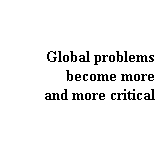 The process of globalisation not only represents new opportunities for
more productive interdependence, but also for a new sensibility concerning
the interactions and burdens on the world system. The upheaval in industrial
societies sharpens the senses for the general global conditions of economic
and technological transformation. Transnational relations of the future
present seven challenges:
The process of globalisation not only represents new opportunities for
more productive interdependence, but also for a new sensibility concerning
the interactions and burdens on the world system. The upheaval in industrial
societies sharpens the senses for the general global conditions of economic
and technological transformation. Transnational relations of the future
present seven challenges:
- Even though world-wide population growth has decelerated somewhat,
by the year 2050 between 8 and 10 billion people will inhabit the earth,
with 3 billion in Asia alone.
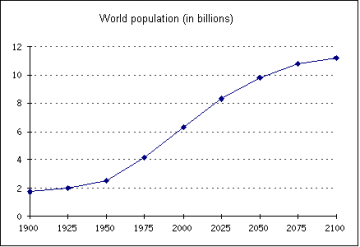
Source: United Nations
The mega-cities of the future will be located in the worlds poorer regions,
where children and youth already form half of the present day population.
Their nutrition, education, and occupation will become the critical questions
of politics. In the meantime, population growth is increasingly narrowing
living space. Greater concentration is leading to social, ethnic and political
conflicts and could become the starting point of mass migrations. At present,
there are over 200 million people fleeing rural poverty for the city,
or conflict regions for stability. In the ageing societies of the northern
hemisphere the population pyramid is reversing and present day social
security systems will be caught in a crisis if a decreasing work force
has to care for an increasing number of persons receiving services.
-
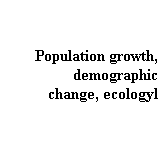 The
spread of toxic substances, the acidifying of lakes and forests, and
the contamination of the atmosphere with effects on the climate and
biosphere have not yet stopped. Burning fossil fuels releases more than
20 billion tonnes of carbon dioxide into the air year after year. If
nothing is done, the world-wide production of carbon dioxide will rise
to 31.5 billion tonnes by 2010. The eastern and south-eastern Asian
countries will replace the USA as the world's greatest emissions producers
with an increase of 180%. The
spread of toxic substances, the acidifying of lakes and forests, and
the contamination of the atmosphere with effects on the climate and
biosphere have not yet stopped. Burning fossil fuels releases more than
20 billion tonnes of carbon dioxide into the air year after year. If
nothing is done, the world-wide production of carbon dioxide will rise
to 31.5 billion tonnes by 2010. The eastern and south-eastern Asian
countries will replace the USA as the world's greatest emissions producers
with an increase of 180%.
- One hundred fifty to two hundred species disappear from the gene
pool daily. On the other hand, goods and services are dependent on the
variety and variability of genes, species, populations and ecosystems.
The genetic material provided by plants, animals, and micro-organisms
holds great potential for agriculture, nutrition, health, the general
well-being of humankind, not to mention the goals of environmental politics.
Agenda 21 rates these biological resources, with good reason, as the
capital stock of the future, i.e. this stock is our potential for obtaining
lasting profits and its increasing destruction is a huge loss for generations
to come.
- The economic development of an ever-growing world population calls
for new methods of producing energy and supplying water. The present
available resources, even if the distribution were to be optimised,
are inadequate. The earth's surface consists of 71% water. Less than
1%, however, is fresh water and thus useful for humans. Increasing consumption,
pollution, and waste are dwindling our resources. At present over 2
billion people are without access to clean drinking water and 5 million
of them die annually from infectious diseases transmitted through polluted
water.
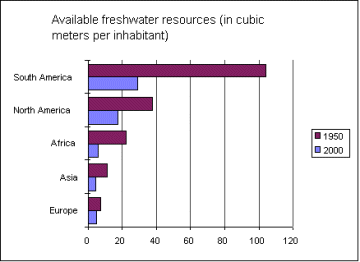
Source: United Nations, Wirtschaftswoche
- The political consequences of demographic, ecological, and social
crises are endangering peace. Growing poverty, disregarding of human
rights, and an ever-increasing population stir up conflict, particularly
in the southern hemisphere. The proliferation of weapons of mass destruction
and their possible use by totalitarian states or terrorists becomes
a global threat as the network of transnational interdependence grows
ever denser. The signs of the times in the approaching century are newly
aroused wars caused by ethno-national, social or religious tensions.
Just Europe and its periphery in the Middle East have seen seven new
regional conflicts since the beginning of the nineties.
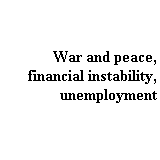 International finance markets have seen an increase in the problems
of globalisation resulting from speculation, hysteria, and automation
of buying and selling. Free and volatile flows of capital pose control
problems for many states and financial institutions. Consider, for example,
monetary speculations that occurred in Europe at the beginning of the
nineties, which led to Britain and Italy's expulsion from the European
monetary system. The collapse of the monetary policy in Southeast Asia
at the end of the century is a further example.
International finance markets have seen an increase in the problems
of globalisation resulting from speculation, hysteria, and automation
of buying and selling. Free and volatile flows of capital pose control
problems for many states and financial institutions. Consider, for example,
monetary speculations that occurred in Europe at the beginning of the
nineties, which led to Britain and Italy's expulsion from the European
monetary system. The collapse of the monetary policy in Southeast Asia
at the end of the century is a further example.
- The old equation of growth and employment is no longer valid for
the global economy. As the expectations for Europe and Asia show, the
employment crisis remains dominant in those areas where structural change
stagnates. According to forecasts, the end of the century will see 16.9
million unemployed for the EU (1989: 12.8 million), 3.75 million in
Asia-Pacific (1989: 2.0 million), and 2.87 in Japan (1989: 1.42 million).
The transnational society is simultaneously confronted with the consequences
of globalisation, the impact of technological change, and the inherited
burdens of the past century. With the globalisation of many political
issues, there is increasing pressure to develop global means for steering
change. Presently, this supplementing of nation-states' political ability
to guide change is, at best, only discernible at regional levels. In many
cases, the political decision makers do not sufficiently accept the new
political challenges. Discrepancy is growing between the actual control
of the global state of affairs by the economy and economic cycles, and
the influence of this reality on the politicians. The question of how
a globally connected economy and society should be efficiently administered,
sensibly governed, and democratically legitimised has yet to be answered.
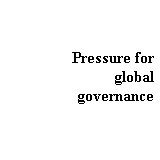 Globalisation
has already changed important democratic circumstances. Politics has lost
the ability to influence incidents when its solution structures do not
keep pace with the internationalisation of problem structures. However,
if it is not possible to fit lost capabilities of nation-states into another
level of democratic framework, then internationalisation drains the democratic
substance from decision-making. Eventually, social conflicts spread if
differing classes and situations of interest do not find politically mediated
balances in the transnational society. On the one hand, the result may
be the development of political extremists who could utilise popular discontent
and endanger the continued existence of democracy. On the other hand,
democracy is in danger of turning into a backdrop where citizen legitimised
action wastes away to symbolism. Globalisation
has already changed important democratic circumstances. Politics has lost
the ability to influence incidents when its solution structures do not
keep pace with the internationalisation of problem structures. However,
if it is not possible to fit lost capabilities of nation-states into another
level of democratic framework, then internationalisation drains the democratic
substance from decision-making. Eventually, social conflicts spread if
differing classes and situations of interest do not find politically mediated
balances in the transnational society. On the one hand, the result may
be the development of political extremists who could utilise popular discontent
and endanger the continued existence of democracy. On the other hand,
democracy is in danger of turning into a backdrop where citizen legitimised
action wastes away to symbolism.
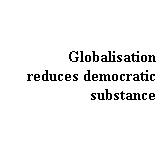 On
this basis, questions for future societies arise in dramatic new ways,
without the present generation being adequately politically or intellectually
prepared. The search for functioning forms of order and society must be
intensified, i.e. is transnationalism also leading to a tightly connected
world civilisation? Are society and economy removing themselves from the
narrow fixation of the nation-state? Does technological change offer solutions
to the urgent economic, ecologic and demographic problems of the future?
Or are compensating opposing trends - trends that will lead to regional
demarcation, national renaissance or state control of new technology -
prevailing? Will this situation more likely lead to global co-operation
or global conflict? On
this basis, questions for future societies arise in dramatic new ways,
without the present generation being adequately politically or intellectually
prepared. The search for functioning forms of order and society must be
intensified, i.e. is transnationalism also leading to a tightly connected
world civilisation? Are society and economy removing themselves from the
narrow fixation of the nation-state? Does technological change offer solutions
to the urgent economic, ecologic and demographic problems of the future?
Or are compensating opposing trends - trends that will lead to regional
demarcation, national renaissance or state control of new technology -
prevailing? Will this situation more likely lead to global co-operation
or global conflict?
The visionary energies of the world seem exhausted and a construction
plan for future political worlds is not in sight. One senses that globalisation
will have similar revolutionary social and psychosocial consequences and
side effects to the social question of the 19th century. And still, the
fears and models of the past dominate the debate on the future. Insights
from the political world on the necessity of new political categories
and strategies to implement the third wave of the industrial revolution
are still pending. Three central questions are at the heart of this clarification
process:
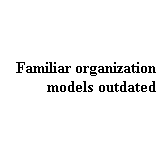 How can adaptations in commerce, employment, and distribution be carried
out so that economic prosperity is possible and ecologically sensible
in the future?
How can adaptations in commerce, employment, and distribution be carried
out so that economic prosperity is possible and ecologically sensible
in the future?
- What do political freedom and democracy mean in a limitless society?
- What impact do these changes have on human identity and social cohesion?
As long as these basic questions remain open, the turn of the era will
occur without orientation on how to effectively build these fundamental
achievements for the future. At present, the societies of America, Europe
and Asia are living in an 'interregnum' in which every thesis and tendency
finds its opposing thesis and tendency.
The phenomenon of compensation determines the pulse of our time. No orienting
picture of the future is bringing social controversy to a head, no unequivocal
trend that could carry us over the threshold of the millennium, and no
means which specify what we should desire are presently discernible. The
assumption of power by such an alliance of disorientation and information
is deeply alarming.
Contents
Chapter 1
Chapter 2
Chapter 3
Chapter 4
TOP
|
 |

